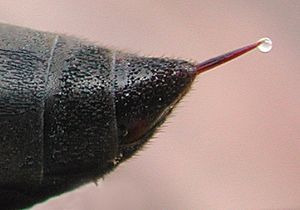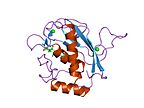Venom facts for kids
Venom is a special liquid made by some animals. It is a type of toxin, which means it can harm or kill. Animals deliver venom into another creature's body, usually through a bite or a sting. They use special tools like fangs or a stinger to do this. This process is called envenomation.
Contents
What Animals Have Venom?
Venom is found in many different animals, both on land and in the sea. It has developed in many ways over time.
- Insects and Spiders: Many small creatures like spiders, centipedes, scorpions, bees, and wasps have venom.
- Sea Creatures: Some animals in the ocean are venomous. These include jellyfish (like the dangerous box jellyfish), the Portuguese man-of-war, and some sea anemones. Also, sea urchins, cone snails, and even some octopuses can be venomous.
- Fish: About 200 kinds of fish with cartilage instead of bones have venom. This group includes stingrays, some sharks, and chimaeras.
- Snakes: Around 450 types of snakes are venomous. Snake venom is made in glands under their eyes. They deliver it through hollow or grooved fangs.
- Other Reptiles: A few other reptiles also have venom. These include the Mexican beaded lizard, the gila monster, and some monitor lizards like the Komodo dragon.
- Mammals: Only a few mammals are venomous. These are solenodons, shrews, vampire bats, male platypuses, and slow lorises.
How Does Venom Work?
Venoms work in different ways to harm or kill. They usually contain different types of toxins:
- Necrotoxins and Cytotoxins: These toxins kill cells in the body.
- Neurotoxins: These affect the nervous system, which controls how the body moves and feels.
- Myotoxins: These damage muscles.
- Haemotoxins: These stop blood from clotting properly.
How Venom Affects Humans
Venomous animals cause many human deaths each year. In 2013, about 57,000 people died from envenomation.
Scientists are also studying venom for its helpful uses. Venom from over 173,000 species is being explored. It could help treat many diseases.
- Snake Venom: Proteins from snake venom are used to treat problems like thrombosis (blood clots), arthritis, and some cancers.
- Gila Monster Venom: The venom from a Gila monster contains a substance called exenatide. This is used to treat type 2 diabetes.
- Fire Ant Venom: Substances from fire ant venom are being studied. They might help treat cancer and skin conditions like psoriasis.
A field of science called venomics studies the proteins in venom. Scientists want to find out how different parts of venom can be used to make medicines.
How Animals Resist Venom
Animals use venom as a weapon to catch food. But some prey animals have developed ways to resist venom.
- California Ground Squirrels: These squirrels can resist the venom of the Northern Pacific rattlesnake. Their resistance depends on where they live. If there are more rattlesnakes, the squirrels in that area are more resistant. Rattlesnakes have also adapted by making their venom stronger in those areas.
- Kingsnakes: Kingsnakes are snakes that squeeze their prey. They eat many venomous snakes. Kingsnakes have developed a strong resistance to venom. They are immune to the venom of snakes in their area, like copperheads and rattlesnakes. However, they are not immune to venom from snakes like king cobras.
- Eels: Eels are resistant to sea snake venoms. Sea snake venoms have many toxins that affect nerves, muscles, and kidneys. Eels are especially resistant to the venom of sea snakes that hunt them. This shows how both animals have changed over time. Fish that sea snakes do not eat have little resistance to their venom.
- Clownfish: Ocellaris clownfish always live among the stinging tentacles of venomous sea anemones. This is a special partnership where both animals help each other. Clownfish are resistant to the anemone's venom.
Sea anemones produce venom through stinging cells called nematocysts. This venom helps them catch food and scare away predators. It can cause pain and muscle problems. Clownfish have a special protective slime on their bodies. This slime acts like a disguise, making the anemone think the clownfish is part of itself. This stops the anemone from stinging the clownfish. Clownfish can even change their slime to match the specific type of sea anemone they live with.
See also
 In Spanish: Venenos animales para niños
In Spanish: Venenos animales para niños







